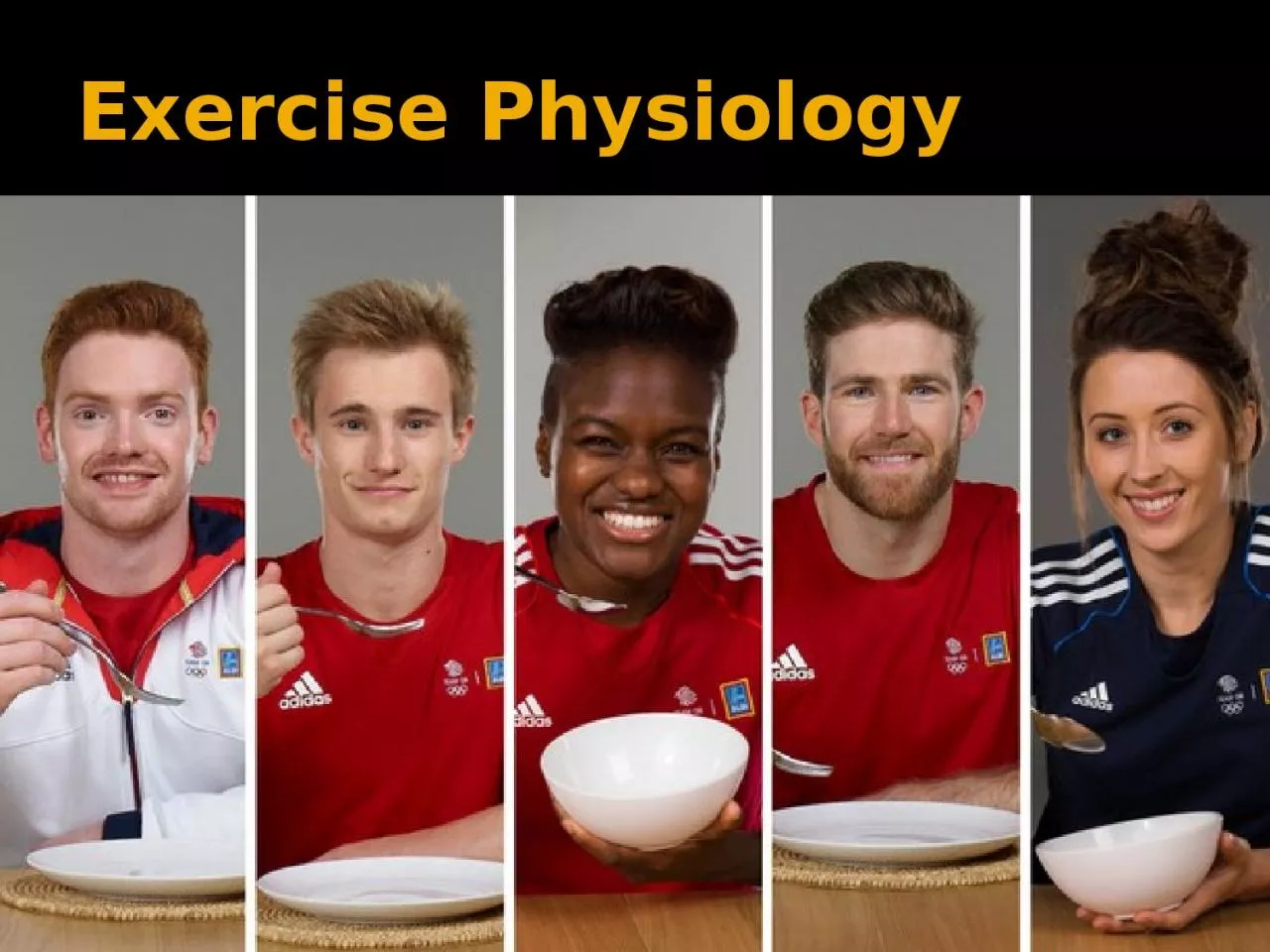

It is crucial that performers meet their energy needs during periods of training If not this can result in Muscle loss atrophy Decreased intensity and duration of performance Slow recovery rates ID: 1039601
Download Presentation The PPT/PDF document "Exercise Physiology Energy" is the property of its rightful owner. Permission is granted to download and print the materials on this web site for personal, non-commercial use only, and to display it on your personal computer provided you do not modify the materials and that you retain all copyright notices contained in the materials. By downloading content from our website, you accept the terms of this agreement.
1. Exercise Physiology
2. EnergyIt is crucial that performers meet their energy needs during periods of trainingIf not, this can result in:Muscle loss (atrophy)Decreased intensity and duration of performanceSlow recovery ratesIncreased risk of injury, fatigue and illness
3. EnergyEnergy is the ability to perform work (measured in joules)4.18 joules = 1 calorieBut what does calorific requirement depend upon?
4.
5. Energy Expenditure – Basal Metabolic Rate (BMR)The minimum amount of energy needed to sustain the body’s essential physiological functions whilst at rest (accounts for 75% of total energy expenditure)
6. Calculating Energy Expenditure
7. Calculating Basal Metabolic Rate (BMR)MALESWrite the answers to these equations first!13.7 x weight in kg = a5.0 x height in cm = b6.8 x age = cThen use them for the calculation:66 + (a) + (b) – (c) = KcalsFEMALESWrite the answers to these equations first!9.6 x weight in kg = a1.8 x height in cm = b4.7 x age = cThen use them for the calculation:655 + (a) + (b) – (c) = Kcals
8. Metabolic Equivalent Task (METs)Calculates the energy expenditure of physical activityThe ratio of a performer’s working metabolic rate relative to their resting metabolic rateUses oxygen consumption per unit of body weight per minute to estimate exercise intensity (ml O2/kg/min)
9. Calculating Energy Expenditure
10. Metabolic Equivalent Task (METs)1 MET = 3.5 ml/kg/min or 0.0175 kcal/kg/minThis is your resting VO2 (volume of oxygen consumed)2 METS indicates the energy expanded is twice that at rest and so on…….
11. Calculating the CaloriesBMR Divided by 24 = Hr BMR8 hrs sleep ( 62 x 8 = Hr BMR x hours sleep) = 496Use the MET list to establish the value for each activity using.Golf Activity = (MET value = 4.5 x hours taken = 4) so 4.5 x.4 = 18 METSOnce the whole day is complete then complete the equation belowEnergy expenditure = 496 + (62 which is hr BMR X total MET= calories per day.
12. Therefore…
13.
14. MICHAEL PHELPS' 10,000 kcal dietBreakfast: Three fried egg sandwiches; cheese; tomatoes; lettuce; fried onions; mayonnaise; three chocolate-chip pancakes; five-egg omelette; three sugar-coated slices of French toast; bowl of grits; two cups of coffeeLunch: Half-kilogram (one pound) of enriched pasta; two large ham and cheese sandwiches with mayonnaise on white bread; energy drinksDinner: Half-kilogram of pasta, with carbonara sauce; large pizza; energy drinkshttp://www.youtube.com/watch?v=QXRvXtcSu14
15. Energy BalanceYou are in energy balance if the amount of energy you take in equals the amount of energy you expend.
16. Calorie CountingSplit down into percentages of food sources of a balanced dietThen split further into different energy yields from food sourcesComplicated?
17. Calorie Counting – PercentagesUsing your BMR+METS total Calculate:Carbohydrates requiredFats requiredProtein required
18. Energy YieldsThese food sources provide different energy yields in calories per gram:Carbohydrates provide 4 Calories (per gram)Fats provide 9 Calories (per gram)Proteins provide 4 Calories (per gram)Using your Carbohydrates / Fats / Proteins totals, calculate the amount of grams of these you would require!
19. Mo Farah Traininghttp://photos.oregonlive.com/photo-essay/2013/04/a_day_in_the_life_with_long_di.htmlhttp://www.oregonlive.com/trackandfield/index.ssf/2013/04/for_mo_farah_and_galen_rupp_it.html#incart_m-rpt-2
20. NameAgeWeight (kg)Height (cm)Basal Metabolic Rate (Kcals)Activity PerformedMETs RateKcals burned (METs calculation)TOTAL =
21. Exam Question 2013Evaluate the dietary intake of the recreational endurance performer in table 1 below. Include recommendations for improving the dietary intake in your answer.State one way in which the diet of an elite endurance athlete should contrast with the recreational endurance performer from table 1.[5 Marks]Dietary Component% of Dietary IntakeProtein15Fats / Lipids45Carbohydrate40